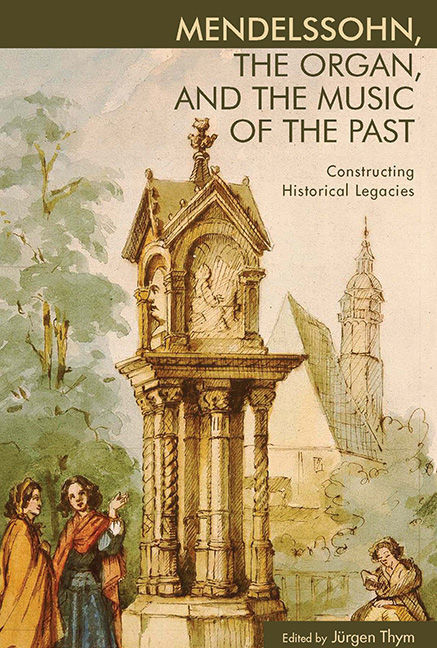Book contents
- Frontmatter
- Dedication
- Contents
- Acknowledgments
- Introduction: Of Statues and Monuments
- Part One Composition and Tradition
- 1 Mendelssohn and the Contrapuntal Tradition
- 2 Mendelssohn and the Catholic Tradition: Roman Influences on His Kirchen-Musik, Op. 23 and Drei Motetten, Op. 39
- 3 Mendelssohn and the Legacy of Beethoven's Ninth: Vocality in the “Reformation” Symphony
- Part Two Mendelssohn and the Organ
- Part Three Mendelssohn's Inherited Legacies in Context
- List of Contributors
- Index
1 - Mendelssohn and the Contrapuntal Tradition
from Part One - Composition and Tradition
Published online by Cambridge University Press: 14 March 2018
- Frontmatter
- Dedication
- Contents
- Acknowledgments
- Introduction: Of Statues and Monuments
- Part One Composition and Tradition
- 1 Mendelssohn and the Contrapuntal Tradition
- 2 Mendelssohn and the Catholic Tradition: Roman Influences on His Kirchen-Musik, Op. 23 and Drei Motetten, Op. 39
- 3 Mendelssohn and the Legacy of Beethoven's Ninth: Vocality in the “Reformation” Symphony
- Part Two Mendelssohn and the Organ
- Part Three Mendelssohn's Inherited Legacies in Context
- List of Contributors
- Index
Summary
We might begin with a statement uncontroversial enough: in matters of counterpoint, Mendelssohn was preoccupied with the music of J. S. Bach. The evidence is formidable and irrefutable. It is not just that Mendelssohn was disposed to writing fugues and canons, or to insinuating into his music familiar Lutheran chorales in order to accumulate extra layers of complexity. More to the point, Mendelssohn took the trouble to emulate distinctly Bachian counterpoint—I am thinking here of his preference for rich, involved, chromatic part writing—that was for the time historically remote and learned. Thus, as early as 1827 he published an erudite fugue in A major as the fifth of the Sieben Charakterstücke for piano (MWV U60; op. 7, no. 5)—a mirror-inversion fugue laden with augmentation and diminution, as though, one weary reviewer from the Leipzig Allgemeine musikalische Zeitung reported, “the composer officially wished to demonstrate how diligently he had studied and mastered his subject through counterpoint.” In subsequent fugues Mendelssohn never exceeded the dense accumulations of special devices in this composition, but he did return to the esoteric technique of mirror inversion in the piano Fugue in B Minor (MWV U131; op. 35, no. 3 [1837]) and in the first movement of the Organ Sonata (MWV W56; op. 65, no. 1), and, perhaps most tellingly, incorporated a mirror-inversion fugue into the overture to Elijah (MWV A25, op. 70). There the inverted subject lends extra emphasis to the depiction of a world turned upside down by the calamitous seven-year drought, announced by the prophet in the opening recitative.
Presumably, Mendelssohn's attraction to Bachian counterpoint was what led Hector Berlioz, who viewed the strictures of fugal composition as an “unpardonable offense against musical expression,” to aver that his colleague was “a little too fond of the dead.” (Berlioz also acknowledged, it should be added, that Mendelssohn possessed “une des capacités musicales les plus hautes de l’époque.”) Berlioz's rejection of traditional counterpoint reflected in no small way his student experiences at the Paris Conservatoire, where he encountered not so much the rigors of Bach as the annoying pedagogical habits of another scrupulous contrapuntist, Luigi Cherubini, who will briefly emerge later in this essay.
- Type
- Chapter
- Information
- Mendelssohn, the Organ, and the Music of the PastConstructing Historical Legacies, pp. 15 - 39Publisher: Boydell & BrewerPrint publication year: 2014

